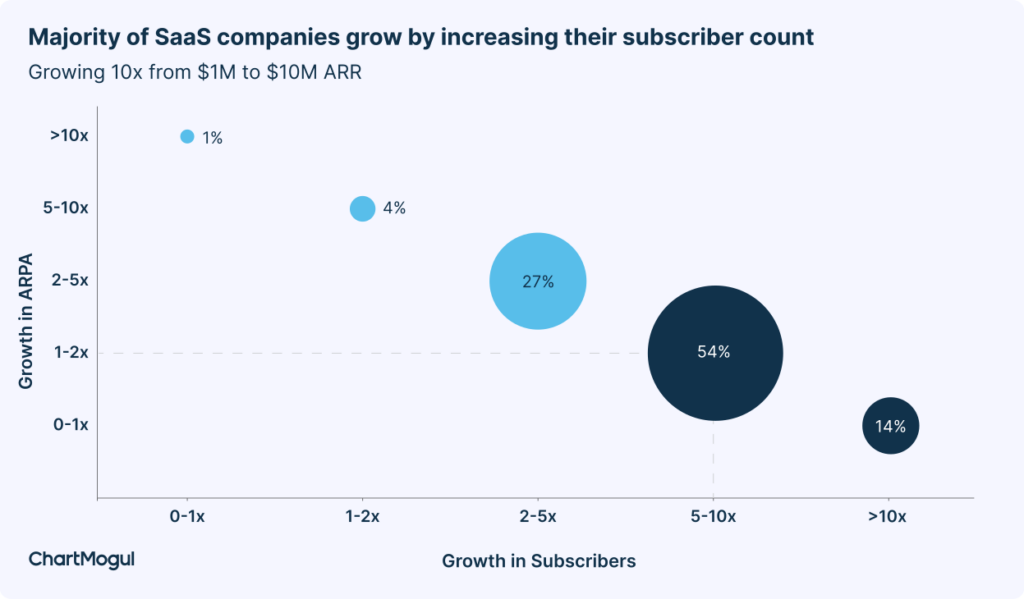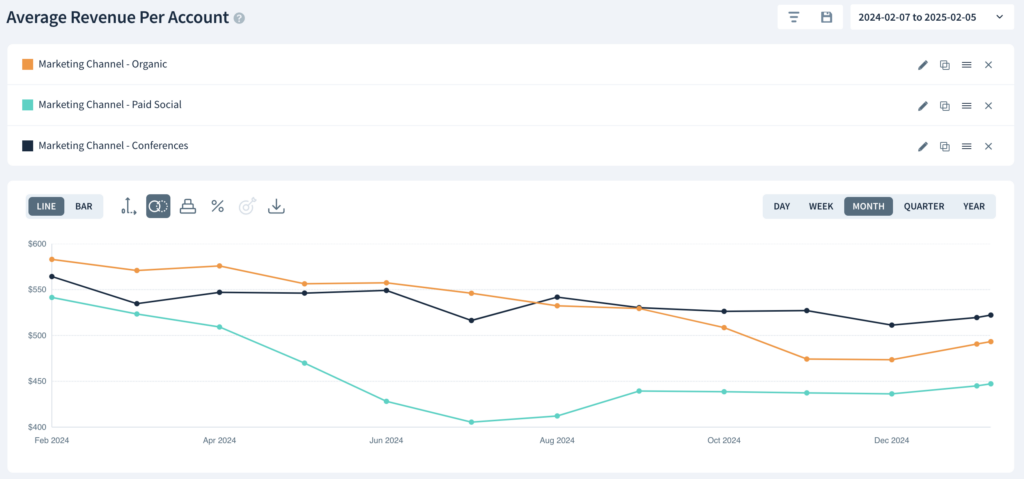When and how to launch sales and marketing is a tough topic for most startup founders. It often means investing a lot of time and money without certainty that it will pay off.
But sales and marketing are the backbone of every successful go-to-market (GTM) strategy, and getting them right can be the difference between thriving and barely surviving, especially in the early days of your SaaS company.
New business is the key to SaaS growth
Our research shows that the most common path for SaaS startups to grow from $1M to $10M ARR is by increasing the number of customers they serve. Growth hinges on two key factors: subscriber (customer) growth and Average Revenue Per Account (ARPA) growth. Most successful startups grow by focusing on increasing their subscriber base.

To grow your subscriber base, you need strong marketing and sales. A great product alone isn’t enough. Consistent outreach, targeted messaging, and a clear value proposition will drive customer acquisition and fuel your growth.
Sales and marketing are stronger together
Traditionally, sales and marketing have been viewed as separate functions, each overseen by its own strategist. Marketing focuses on creating awareness of the company and its products, while sales is responsible for converting that awareness into customers.
However, in the modern SaaS industry, seeing these functions “as separate activities” isn’t the best approach. Sales and marketing need to work as an integrated team, even if they report to different leaders. Here’s why:
1. Product-led growth (PLG) changed the traditional sales and marketing departments
When a startup follows the product-led growth (PLG) methodology, the product itself drives customer acquisition, conversion, expansion, and retention. PLG is really popular amongst SaaS companies in part because it’s efficient and can bring rapid growth very quickly.
In product-led SaaS companies, marketing initiates the customer journey by driving awareness of the product via promoting free trials, demos, or freemium versions, acquiring leads by having them directly interact with the product. Even in PLG, sales gets involved. They focus on the highest-value leads which are already using the product and showing signs of upgrade readiness. This approach is commonly called Product-led Sales (PLS) and works alongside PLG strategies to ensure your most valuable leads have the highest chance of conversion.
The PLG “try-before-you-buy” approach means that both sales and marketing share responsibility for guiding the user through a seamless journey within the product, which requires close coordination.
2. Both marketing and sales adapt based on feedback from customers
In SaaS companies, every user interaction offers valuable insight that can inform marketing, sales, and product decisions. This insight is useful for all GTM models, including both PLG, sales-led growth (SLG).
Marketing can analyze which features attract the most users or generate the highest engagement. Then, they can collaborate with sales to prioritize those features in conversations with prospects. Sales, in turn, provides feedback on customer pain points and objections, which marketing can address in campaigns or content.
The real-time flow of feedback, insights and data between marketing and sales ensures that they work as a unified force focused on the same goal: driving product adoption, customer acquisition, and long-term customer value.
3. Sales and marketing teams must align on customer fit early on to impact retention
SaaS revenue growth depends on customers continuing to subscribe and use the product more and more over time.
Acquiring new customers is important, but it’s not the only consideration. Subscribers who will stick around, renew their subscriptions, and expand their usage over time are the most valuable customers in SaaS. Retention is the highest long-term priority which means sales and marketing must align on a shared and clear understanding of the company’s ideal customer profile (ICP).
“Growth happens when your marketing and sales efforts focus on the same ideal customer profile (ICP), using strategies from both teams to attract and convert the best customers for the business.”
— Rachel Whitehead, VP of Marketing, ChartMogul
Together, marketing and sales should collaborate to attract users who match the company’s ICP—those who see value in the product from the start and are likely to stay long-term. By aligning on customer fit early on, marketing can target campaigns that resonate with high-retention prospects, while sales focuses on nurturing relationships that show promise for long-term value.
Creating a sales and marketing powerhouse
Getting teams to work well together is easier said than done. It’s important that you consider marketing and sales as collaborative from day one. That means having each involved in key GTM hiring processes, aligned on the shared GTM tech stack and developing their strategies together.
Here are the core shared activities sales and marketing should complete together:
Develop a shared ICP vision
Bring sales and marketing together for a collaborative session where you define your ideal customer profile (ICP) based on your existing customer data and firsthand experience. You’re looking for patterns (size, industry, geography etc.) in what makes a high-value customer using inputs like::
- Which type of companies remain customers the longest?
- Which type of companies convert fastest?
- Which type of companies are the easiest to sell to?
- Which type of companies pay you the most?
If you don’t have many customers yet, rely more on your existing experience or interview leaders and partners in your space for their insights.
An ICP is a clear, written profile with details of your target customer, such as industry, company size, key user job titles, pain points, and buying triggers.
Having a clear understanding of your ICP will make it easier for marketing to target the highest quality leads for sales to convert, maximizing your potential success.
Learn more about the why, how and what of ICPs from experts in the field.
Implement a shared CRM and GTM tech stack
As a company grows, sales and marketing often begin to operate in silos, drifting further apart. This largely happens because of a growing and fragmented tech stack.
You can bridge this gap (or proactively address it) by implementing a centralized CRM that works for both teams, where they can access, share, and act on the same data.
ChartMogul CRM is a straightforward system that lets you collect leads, manage your sales pipeline, and have full control of your relationships with each user. A subscription analytics platform in the first place, ChartMogul combines SaaS revenue and retention data with customer relationship management in one system.
Set common goals and targets
Alongside isolated metrics—like leads generated for marketing and win rate for sales—both teams should be accountable for revenue-related targets. Annual, quarterly or monthly targets should be set together, with each team clear on how their KPIs fold up to the GTM team’s goals.
You can set shared targets around::
- New business revenue
- Sales pipeline
- Revenue growth rate
- Conversion rates
- Customer Lifetime Value (LTV)
- Customer Acquisition Cost (CAC)
- (and sometimes) Revenue retention and expansion metrics, like Net Revenue Retention (NRR) and Expansion MRR*
*While you can’t attribute 100% of these outcomes to sales and marketing alone, it’s important to recognize the contribution these teams make to overall success.
Integrate your channel data with Subscription Analytics
How do you connect marketing and sales efforts to big-picture metrics like customer retention and LTV? With ChartMogul, it’s easy. Just tag your campaigns, send the conversion data, and let ChartMogul generate clear, insightful reports. You’ll see exactly which channels and campaigns are bringing in the longest-retained customers and most revenue—no guesswork required.
Here, you’ll find a step-by-step guide to tying your marketing channel data to revenue metrics with ChartMogul.
Build the funnel together
It’s no surprise that 47% percent of sales and marketing teams agree that having separate funnels is the most common reason for their misalignment.
- Schedule a dedicated session where sales and marketing can discuss and align on what constitutes a Marketing Qualified Lead (MQL), a Product Qualified Lead (PQL), and a Sales Qualified Lead (SQL). Both teams should have a clear understanding of when and how a lead should transition from marketing to sales.
- Once MQL, PQL and SQL criteria are defined, create a shared funnel flow chart that illustrates the journey leads take from initial awareness to becoming customers. Label each stage with specific actions or attributes that define the transition between them.
- Establish clear handoff protocols. Define exactly when and how leads should be passed from marketing to sales. Set up automation in your CRM to automatically notify sales when a lead becomes an SQL.
When all is set, keep an open feedback loop between sales and marketing. When marketing provides leads to sales, sales should provide feedback about the quality of those leads and whether they fit the criteria. Similarly, marketing should regularly check in with sales to refine lead nurturing strategies and identify trends in lead qualification.
Sales and marketing 101
The role of a sales team in a SaaS startup
Put simply, the sales team’s job is to convert high-quality leads into paying customers. Leads arrive in two main ways: inbound, and outbound. Sales teams run different motions to convert these leads.
Outbound sales
Outbound leads are created by sales themselves. Typically, a sales rep proactively researches prospects who could be great customers one day. Using the company’s agreed upon ICP as a blueprint, they create lists of prospective customers and nurture them into sales opportunities. To do this, sales may use cold outreach, prospecting, and personalized follow-ups to create interest and guide prospects through the sales funnel.
“Many SDR teams strive to book meetings, and while that was a top priority for us, we also encouraged prospects to trial our product. This is because many of our buyers prefer to evaluate the capabilities of our product without sales assistance — and ‘being aligned’ with prospects is a core value of our sales culture.”
— Sara Archer, VP of Sales, ChartMogul
Ultimately, we decided to pull the plug on our outbound sales strategy.
Inbound sales
Inbound leads are people who arrive in your funnel organically. Typically, inbound is built and scaled once a marketing team is on board. Here, prospects first engage with the company’s marketing content—like articles, webinars, or eBooks—and leave their contact information. The marketing team qualifies these leads and then hands them to inbound sales development representatives (SDRs) once they’re identified as sales-ready. Inbound SDRs focus on nurturing these interested leads and moving them closer to a purchase.
SaaS sales typically follow consultative selling
Many SaaS sales teams follow the consultative selling philosophy. In these teams, each sales rep acts as a consultant, focussed on understanding and addressing the customer’s pain points, and helping educate the buyer about a better solution, using their product.
“Only when you have developed a keen understanding of your customer’s needs can you earn the right to ask questions about their decision-making process.”
— Sara Archer, VP of Sales, ChartMogul
Product-led sales teams focus on user education
SaaS products can be complex, so sales teams frequently take on an educational role, offering demos, webinars, and personalized onboarding sessions. This is particularly true in PLG companies, where the sales team play an assistive role, alongside the product itself.
Emphasis on customer success
Once a deal is closed, the relationship doesn’t end. SaaS sales teams work closely with customer success teams to ensure customers see value in the product, helping to reduce churn and identify upsell or cross-sell opportunities.
The role of a marketing team in a SaaS startup
Marketing can take on countless forms and serve all kinds of goals, including building brand awareness, bringing in leads, or strengthening customer relationships.
For early-stage SaaS companies, the top priority is usually generating quality leads. Like sales, SaaS marketing can be divided into two types: inbound and outbound.
Inbound marketing
Inbound marketing involves drawing people in by offering content that’s helpful and relevant to them and promoting it through owned media such as:
- Blogs, podcasts, videos and other content
- SEO
- Social media
- Email newsletters
Search engine optimization (SEO) plays a crucial role in shaping these content marketing efforts, ensuring that the content reaches a broad audience effectively.
Outbound marketing
Outbound marketing is more about reaching out to potential customers directly, instead of waiting for them to find you. Unlike inbound, which relies on owned media, outbound marketing typically uses paid or direct outreach channels:
- Paid ads (e.g. search ads, social media ads, etc.)
- Press releases
- Partnerships
- Sponsored events
Product-led marketing
In PLG the SaaS marketing team’s role is to promote the product experience itself. Marketing focuses on driving free trials and product demos to attract potential customers and let them experience the product themselves. Product-led marketing tends to be high-scale, with many hundreds of users testing out the product at any one point, guided by automated marketing triggers.
Lifecycle marketing
Marketing efforts don’t stop once a customer signs up. SaaS marketers design campaigns tailored to each stage of the customer journey, from awareness to advocacy. This may include onboarding emails, in-app messaging, or educational content aimed at helping existing customers get the most value from the product and stay engaged over time.
Content and thought leadership
Since SaaS products often serve niche or technical needs, marketing teams focus heavily on content that educates and builds credibility. Blogs, case studies, webinars, and white papers help position the brand as an industry expert while addressing specific customer challenges and use cases.
Alignment with sales and customer success
SaaS marketing teams work closely with both sales and customer success to create a cohesive customer journey through aligned sales and marketing efforts. For example, they may develop content that helps sales explain key product benefits or design campaigns to support customer success in onboarding and retention efforts.
What comes first: sales or marketing?
In the pre-seed and seed stages of SaaS growth, many companies choose to start with outbound sales motions, with the founders being active participants in the sales process. At this stage, budgets are tight, and spending heavily on advertising or content production doesn’t seem like a good investment.
However, integrating marketing into the acquisition strategy early can provide significant benefits for young companies.
Marketing campaigns, especially content marketing, social media, and even small paid ad tests, can generate valuable data on your ideal customer profile (ICP). For instance, you’ll start to see which customer segments are most engaged, what messaging resonates best, and which pain points seem to drive interest. This data helps the sales team refine their approach and focus on leads that fit the ICP.
For example, by segmenting the ARPA report inside ChartMogul by marketing channel, you can understand which channels are bringing in more higher-paying customers.

What’s more, a strong brand presence makes it much easier to sell. Brand-building activities—like creating helpful content, sharing customer success stories, or establishing a presence on key platforms—lay the groundwork for smoother sales interactions.
In short, while sales might drive strong results in the very early days, sustainable growth can only be achieved by integrating both sales and marketing into GTM efforts.
What’s your GTM motion?
SaaS companies typically fall into one of these categories when setting up their sales, marketing and GTM motions:
Sales-led (also known as enterprise sales)
With a high-touch model, sales reps guide prospective customers from initial interest to a purchase decision. In this model, the sales team is the primary source of all new business revenue.
“Traditionally in sales there was an information asymmetry where the buyer needed access to information to make a decision. A salesperson gated it from them as leverage to then engage them in a sales process. That has gone away.”
– Nicholas Mills, President, Pitch
The shift to subscription-based models has changed how SaaS companies operate these days. And it’s impacting sales teams, too.
Self-serve or product-led
Here, prospects sign up for the product and subscribe to a plan independently. In these companies, there may not be any sales reps at all, or there may be a small number who only step in to close deals with high-value prospects who show interest in enterprise-level plans or significant expansions.
In a product-led growth strategy, the product is used as the growth engine. However, this does not eliminate the need for sales teams.
“If you are a product-led business, product-led sales is what you can add on top of that, to support that process. It’s basically a way to extract more value from your product-led growth model, by adding sales into it.”
– Esben Friis-Jensen, Co-Founder, Userflow
Hybrid: a combination of self-service and high-touch models
It’s more common to create a hybrid approach that combines self-service and high-touch models to reach different audience segments effectively.
Prospects can self-serve for initial sign-ups or trials but also have the option to engage with sales—whether for purchasing, upgrading, or requesting a tailored solution.
Check out our full breakdown of SaaS sales models and typical sales processes.
Sales and marketing FAQ
What is sales?
Sales is responsible for converting leads into paying customers. It involves building relationships with potential customers, understanding their needs, and providing solutions that meet those needs. Sales professionals close deals, meet sales targets and drive revenue for the business.
What is marketing?
Marketing focuses on promoting a product to potential customers. It involves creating awareness, generating interest, and building demand for a product or service. Marketing teams develop marketing campaigns, create engaging content, and interact with customers through various channels.
What are common tools marketing and sales teams use?
Sales and marketing teams use Customer Relationship Management (CRM) to manage leads, track interactions, and analyze customer data. CRM tools allow sales and marketing professionals to focus on strategic activities that drive business growth.
